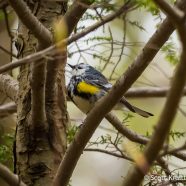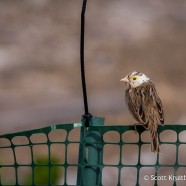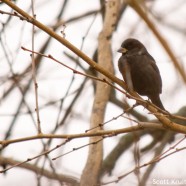White Squirrel
One of the most familiar backyard creatures we have in the eastern part of the United States is the Eastern Gray Squirrel (Sciurus carolinensis). They are on our trees, robbing our bird feeders, “begging” for a snack in the park, but they are not always all the same. Some areas have local populations of melanistic, leucistic, or albino squirrels, and in some cases, these black or white appearances seem to possibly even be a color morph. I photographed this squirrel last week, and its dark (not red) eyes suggest it is not an albino even though it looked so very white. Such a...
Read MoreLeucistic Yellow-rumped Warbler
Here is that unique Yellow-rumped Warbler which I mentioned in a previous post. Can you see what looks different about it? I noticed it naked eye while tracking various subjects in a loose flock through the trees last week including more Yellow-rumps, Black-and-white Warblers, Blue-headed Vireos, and Blue-gray Gnatcatchers. After I got my binoculars on it I realized this bird was partially leucistic, and I quickly raised my camera to snap off a record photo. Leucism in birds is when melanin pigments are produced at less than normal levels or in an unexpected pattern. In this case many of the...
Read MoreLeucistic Savannah Sparrow
This appears to be a partially leucistic Savannah Sparrow, a migrant individual that I was surprised by yesterday morning. Leucism is when pigments are produced at less than normal levels or in an unexpected pattern. In this case many of the feathers on the head and throat do not have typical pigmentation. Interestingly the yellow patch on the face can still be seen, giving this unique bird an all the more fascinating look. Scott Kruitbosch Conservation & Outreach Coordinator
Read MoreMelanistic House Sparrow (Passer domesticus)
This is one House Sparrow (Passer domesticus) I have never seen before! I took these shots last weekend, the bird being part of a group of well over 100 House Sparrows. The photos are very true to real life appearance and have not been heavily edited. Do you know why it is so dark? It appears to be melanistic which means that the dark-colored pigment melanin in the feathers was produced at higher than normal levels creating an abnormal color. The opposite is known as leucism where pigments are produced at less than normal levels or in an unexpected pattern. Melanism in small songbirds is...
Read More







